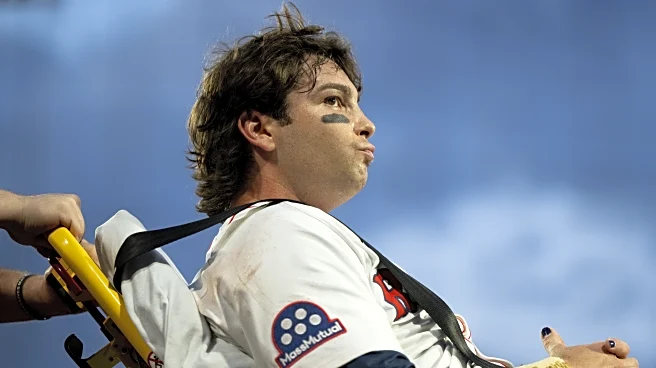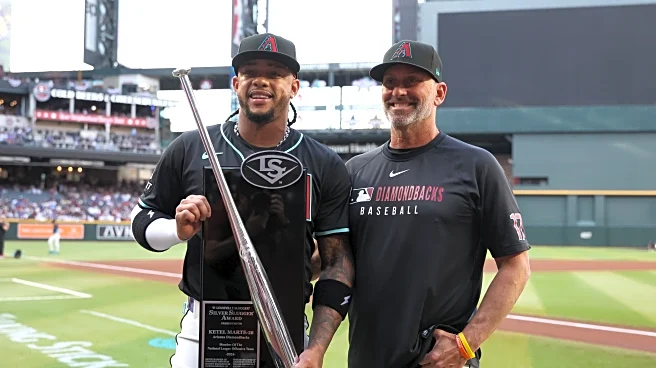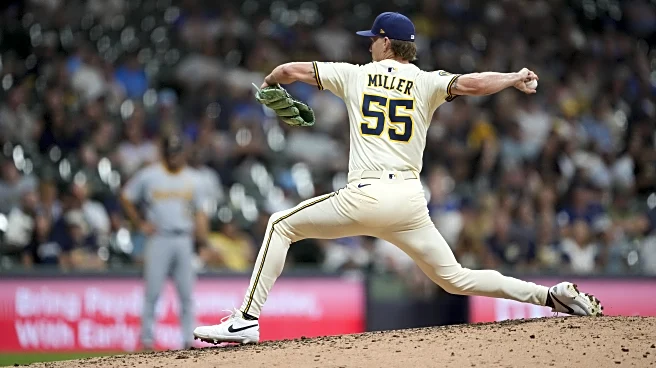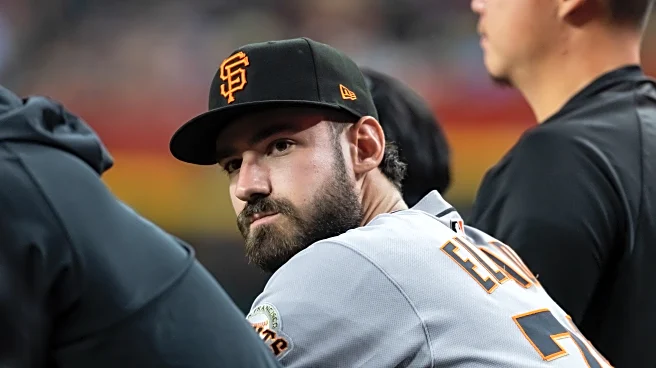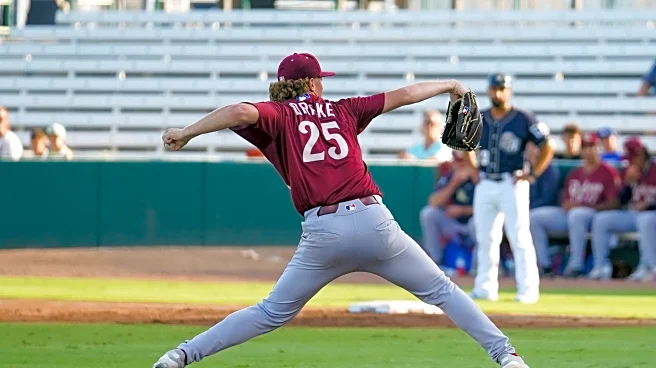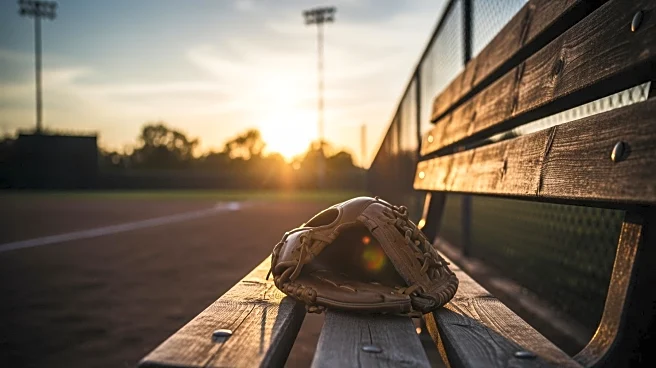How the rotation for Arizona performed this year kinda depends on what metric you choose, as well as how you look at it. By straight ERA, they were mediocre: 4.29 ranked the D-backs’ starting pitching nineteenth. It was considerably better than the 4.79 ERA and 27th ranking they managed in 2024. They certainly got their work in over 2025 too – only the Phillies and Guardians saw their rotation throw more innings. But was it because they D-backs’ starters were good, or because manager Torey Lovullo
was scared to go to the fragile and unreliable bullpen? That is a very legitimate question.
It is true that even the improved ERA is disappointing, considering how the team was set up with the rotation looking to be a strength before the season. The arrival of Corbin Burnes had set expectations very high: USA Today had Arizona’s starting pitching ranked fourth-best in the majors, and Fangraphs was hardly less bullish, putting the D-backs sixth in the final week of March. That certainly didn’t turn out to be the case. Two of our everyday starters posted an ERA above five, and a third was in the same area for the majority of the campaign. We’ll be getting into these further during our player reviews, but here’s our Opening Day rotation fared.
- Zac Gallen: Big things expected in his contract year, failed to materialize. While 192 IP was a good total, a 4.83 ERA and fifteen losses were both the worst figures of Gallen’s career.
- Merrill Kelly: As solid as ever in a D-backs shirt, posting a 3.22 ERA before being dealt to Texas at the deadline – and not being great there.
- Brandon Pfaadt: Received a $45 million contract extension shortly before Opening Day, but yet again, the breakout campaign failed to materialize. Among qualified starters, his 5.25 ERA ranked 48th of 52.
- Eduardo Rodriguez: Barely better than replacement level (0.2 bWAR), and certainly worth well short of his $20 million salary in 2025. Did improve his ERA over the previous year. By two-hundredths of a run.
- Corbin Burnes: The awkward relegation of Burnes to #5 and a couple of rough starts, were soon forgotten as his ERA dropped below three. Unfortunately, elbow issues ended his year on June 1.
The only other pitcher to make more than five starts was Ryne Nelson, and he was a rare ray of sunlight in the generally cloudy day which was the 2025 rotation. He was tagged with the loss only three times over 23 starts, and had a 3.16 ERA in that role, once he was allowed into it.
Current candidates
With the departures of Kelly and, as is widely expected, Gallen to free agency, and Burnes not returning in time for the start of next season, the D-backs currently only have three starting pitchers who can be solidly penciled into the 2026 rotation. They are, in alphabetical order:
Ryne Nelson: MLB 154 IP, 3.39 ERA, 3.73 FIP, 3.4 bWAR
Certainly a candidate for Most Pleasant Surprise of 2025. However, the uptick in results was not matched by any change in peripherals:
2024: HR/9 1.0; BB/9 2.0; K/9: 7.5; FIP 3.74
2025: HR/9 1.0; BB/9 2.4; K/9: 7.7; FIP 3.73
The main difference in inputs was a BABIP drop from .309 to .252; meanwhile Nelson’s hard-hit percentage actually increased, from 41.6% to 45.6%. There’s rather too much blue on his Baseball Savant page for comfort.
Brandon Pfaadt: MLB 176.2 IP, 5.25 ERA, 4.22 FIP, 0.6 bWAR
Another year, another disappointing campaign for Pfaadt. We’ve been waiting for him to deliver on the promise shown during the 2023 postseason run, but over almost 360 innings since, his ERA is almost five. However, in both 2024 and 2025, Pfaadt’s FIP was more than a run below his ERA. Of the 114 pitchers to throw 200+ innings since the start of 2024, nobody has a bigger gap than Brandon’s 1.07. So maybe it’s just a question of patience, and waiting for ERA to regress down. Though this season’s 4.22 FIP is really nothing special, and since Pfaadt is now 27 years old, “He’s still young” is increasingly shaky as any kind of excuse.
Eduardo Rodriguez: MLB 154.1 IP, 5.02 ERA, 4.57 FIP, 0.2 bWAR
Rodriguez actually make the FIP/ERA gap top twenty too, at #16 – though at 0.45, it’s less than half that of Pfaadt. There were occasional encouraging signs from E-Rod. When he came off the IL in June, he had a sub-two ERA across five starts. But there was no real consistency (despite E-Rod opening the season with five Game Scores all in the 49-52 range!): his last four outings went 0 ER, 5 ER, 0 ER, 5 ER. He has been paid $34 million by Arizona since signing, with an ERA above five in both seasons. There’s at least another two years and a further $46 million to go. So, really, all we can do is hope for better.
Internal candidates
Things don’t look quite so grim on the farm as they did before the trade deadline. At that point Cristian Mena was arguably the only one of the team’s top 20 prospects who might help the team next year. But the arrival of Kohl Drake (now our #6, per MLB Pipeline) and Mitch Bratt (#9) from Texas in the deal for Merrill Kelly, adds those two to the list of potential pitchers. Along with Mena, it’s possible they could end up competing for the team’s fifth rotation spot in spring training. At the very least, they will provide much-needed depth to the rotation, and I would not be at all surprised to see all three pitch in the majors during the 2026 campaign.
Both Mena and Drake will have to show they have returned to health first. Curiously, both had their seasons ended by similar injuries: a shoulder sprain. Mena went on the IL on June 7th. While there was hope expressed by Torey Lovullo in August that he might see action this year, that proved not possible. Left-hander Drake did make seven starts and one relief appearance for the Reno Aces after the trade, but was placed on the development list in late August due to a desire to limit his workload, and that’s when his sprained shoulder showed up. Bratt, also a leftie, made six starts for Double-A Amarillo, and I imagine will likely start in Reno next year.
Beyond that trio, just about everyone else in our top thirty prospects is looking likely to be for 2027 or later. Previous possible contenders Yu-min Lin and Yilber Diaz both saw their share of struggles this year. The latter, in particular, developed an astonishing case of the yips, walking 64 people in just 41 AAA innings. But of the nine pitchers to make 10 or more starts for Reno, Mena and 35-year-old Casey Kelly were the only ones with an ERA below 6.30 as an Ace. Even allowing for the environment there, that’s unimpressive. If our rotational health regresses to the mean next year, depth could definitely pose a problem.
New candidates
The most obvious “new” name is, of course, a very old name. The general consensus is that the team will make a play to bring back Kelly, after having dealt him away at the trade deadline. When he returned to Chase Field with the Rangers, he said, “Coming home is obviously very attractive, not only for me but for the family aspect as well. At the same time, I’ve put myself in a position to have what is hopefully a decent market… Coming home and being a Diamondback is never ever off the table.” Jack Sommers looked at a possible deal and suggested Arizona could offer $12 million for 2026, plus a team option at the same price for 2027, with a $3 million buyout.
A return by Zac Gallen seems unlikely, with the consensus very much being he will accept the team’s qualifying offer and test free agency. However, given his shaky results in 2025, I would not completely rule out him re-signing for a year, and looking to post a better contract walk season, before re-entering free agency next winter. There will definitely be better options than Gallen on the market. The starting pitchers who will be available, are probably led by Dylan Cease, Ranger Suárez and Framber Valdez. While there’s no obvious ace, seems that candidates at a price to suit all pockets will be out there. The question is, how much are Arizona willing to spend?
That is certainly going to be a factor here, with the payroll likely shrinking from the record levels seen in both 2024 and 2025. Rather than going into the free-agent marketplace, it’s possible the team might end up trading for a starting pitcher with good team control, as we discussed earlier in the week. However, the uncertainty over the 2027 season, and a potential lockout, may also factor into the team’s decisions here. They could opt to circle the wagons and focus purely on next year, rather than spend money and/or prospect capital, for games which will potentially never be played.
Conclusions
“The starting pitching is going to be something we’re going to need to focus in on going into the offseason for sure. That’s probably the number one area, outside of building the bullpen again.” — Mike Hazen, October 1
The above demonstrates that Hazen knows the assignment. However, understanding the question isn’t the same as finding answers. While it would nice to have a pipeline of pitching prospects, the harsh reality is, the team has been flat out terrible at drafting and developing pitchers. This dates back to before Hazen’s arrival. Since Brandon Webb threw his last pitch in the majors, on Opening Day 2009, our draft selection who has been most productive on the mound for Arizona is… Josh Collmenter. No insult to Josh, but given the number of picks under the bridge over the seventeen drafts since, you’d expect better.
Given this long spell of futility, the team needs to be successful with signings. But outside of Kelly, this has been a struggle too. I needn’t list all the free-agent pitchers who have turned out to be busts as Diamondbacks (again, going back to before Hazen). We got rid of one of the worst this year in Jordan Montgomery, though we will see how Rodriguez shakes down before coming to a formal ranking. The team’s best post-Webb pitcher is Gallen, who arrived as a swap for Jazz Chisholm in July 2019. If a similar partner can be found, then based on previous history, I am inclined to think a trade could be Arizona’s best hope for filling a rotation spot.


